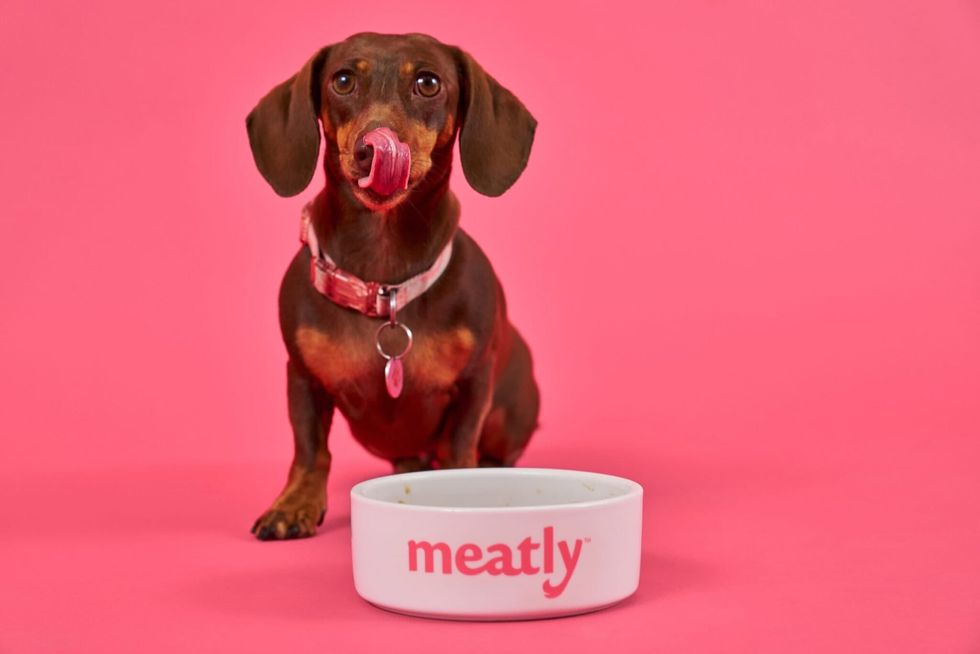Blaze News original: One company's pet project: Build a future for lab-grown meat
The “cultivated meat” industry appears to be experiencing serious growing pains. The sector that once had investors salivating now faces significant technological, financial, and legal challenges — as well as the ever-present fear that consumers just won't bite. 'The same people who are doomsaying it now were hyping it five years ago.' While American players in the lab-grown meat market apparently prefer to suffer in silence — of the 20 startups Align contacted, none responded — we did find one British company forging ahead by targeting a considerably less picky demographic: dogs and cats. And once their pets are on board, can people be far behind? Where's the beef? Things were a lot different just five years ago, when investors' appetites for this new, cruelty-free way to get hamburgers seemed insatiable. Why raise a calf into a fulsome cow, then brain it for chuck when you can simply: Secure a sample of cells from that cow; Take a sub-selection of those cells to grow a “bank” of cells for later use; Deposit some of the banked cells into a tightly controlled tank called a bioreactor, not wholly unlike those you might find in a brewery; Supply the cells with nutrients and other factors (including inorganic salts, vitamins, oxygen, amino acids, glucose, and in some cases fetal bovine serum); Introduce other factors after the cells have multiplied many billions of times over, further modifying the clumping mass of monstrous potential; And harvest the resulting cellular material for processing and preparation? Six simple steps to getting a product genetically indistinguishable from the real thing. A recipe for success Deep-pocketed juggernauts and wide-eyed hopefuls alike were keen to try their hand at this novel and supposedly ethical way of growing money-makers in bioreactors. The idea practically sold itself. Near-universal was the emphasis on sparing livestock from slaughter. A number of companies — including a few that now live on only in disgruntled investors’ memories — also laid it on thick with green appeals, noting that with fewer cows and chickens, less farmland and water will be needed. While there are indications that lab-grown meat will still have a significant carbon footprint, fewer cows might also mean less methane emissions. Others noted that their products are hormone-, steroid-, and antibiotic-free. Still other companies argued that lab-grown meat can help out with food security — reinforcing the supply chain and helping to meet the increasing global demand for meat. Venture capital liked what they were cooking — especially with the market beginning to lose its appetite for plant-based meat. It helped that there had been incredible technological progress over a short period of time, driving down the cost to lab-grow a hamburger from $300,000 to less than $10. Regulators were keen to clear the way — at least stateside, where both the U.S. Food and Drug Administration and U.S. Department of Agriculture approved select prospects for retail. So bullish was Israel-based Believer Meats that the company broke ground on the largest cultivated meat production facility in the world, set to open its doors next year North Carolina, signaling to those still in trials that it might actually be possible to fire off imitation chicken for something other than pop-up food demos. Trimming the fat That was then. Turns out making lab-grown meat into a viable business is harder than many thought. Investment has dropped off, and reality has set in. Those players still remaining are trimming the fat. A winnowing is under way. SCiFi Foods and New Age Eats are two among numerous companies that won’t see the bloodless promised land. Not even Upside Foods, the company that first received FDA approval for its “cultured chicken cell material” in November 2022, made it into 2024 unscathed. Months after Upside rebuked Bloomberg for suggesting it lacked a path to scale its product and spiked plans for an Illinois-based factory, Wired indicated in July that Upside CEO Uma Valeti notified employees that he was canning 26 people; that leadership teams were going to be restructured to “reduce top-heavy structures”; and that he was pausing the “large-scale tissue program.” The Good Food Institute recently noted in its annual state of the industry report that cultivated meat and seafood companies raised $225.9 million global in 2023. The previous year, the industry raised $922.3 million. When accounting for the delta, the GFI — a cellular agriculture advocacy group founded by PETA veteran Bruce Friedrich — noted that last year, “companies and investors alike faced elevated inflation, rising interest rates, and a mixed economic outlook.” Although keen to put a positive spin on a mixed year, the GFI acknowledged that Good Meat, Upside Foods, and other companies “continued to wrestle with the difficulties of scaling production beyond limited quantities, and sectors of the medi


The “cultivated meat” industry appears to be experiencing serious growing pains.
The sector that once had investors salivating now faces significant technological, financial, and legal challenges — as well as the ever-present fear that consumers just won't bite.
'The same people who are doomsaying it now were hyping it five years ago.'
While American players in the lab-grown meat market apparently prefer to suffer in silence — of the 20 startups Align contacted, none responded — we did find one British company forging ahead by targeting a considerably less picky demographic: dogs and cats.
And once their pets are on board, can people be far behind?
Where's the beef?
Things were a lot different just five years ago, when investors' appetites for this new, cruelty-free way to get hamburgers seemed insatiable. Why raise a calf into a fulsome cow, then brain it for chuck when you can simply:
- Secure a sample of cells from that cow;
- Take a sub-selection of those cells to grow a “bank” of cells for later use;
- Deposit some of the banked cells into a tightly controlled tank called a bioreactor, not wholly unlike those you might find in a brewery;
- Supply the cells with nutrients and other factors (including inorganic salts, vitamins, oxygen, amino acids, glucose, and in some cases fetal bovine serum);
- Introduce other factors after the cells have multiplied many billions of times over, further modifying the clumping mass of monstrous potential;
- And harvest the resulting cellular material for processing and preparation?
Six simple steps to getting a product genetically indistinguishable from the real thing.
A recipe for success
Deep-pocketed juggernauts and wide-eyed hopefuls alike were keen to try their hand at this novel and supposedly ethical way of growing money-makers in bioreactors. The idea practically sold itself. Near-universal was the emphasis on sparing livestock from slaughter.
A number of companies — including a few that now live on only in disgruntled investors’ memories — also laid it on thick with green appeals, noting that with fewer cows and chickens, less farmland and water will be needed. While there are indications that lab-grown meat will still have a significant carbon footprint, fewer cows might also mean less methane emissions.
Others noted that their products are hormone-, steroid-, and antibiotic-free.
Still other companies argued that lab-grown meat can help out with food security — reinforcing the supply chain and helping to meet the increasing global demand for meat.
Venture capital liked what they were cooking — especially with the market beginning to lose its appetite for plant-based meat.
It helped that there had been incredible technological progress over a short period of time, driving down the cost to lab-grow a hamburger from $300,000 to less than $10. Regulators were keen to clear the way — at least stateside, where both the U.S. Food and Drug Administration and U.S. Department of Agriculture approved select prospects for retail.
So bullish was Israel-based Believer Meats that the company broke ground on the largest cultivated meat production facility in the world, set to open its doors next year North Carolina, signaling to those still in trials that it might actually be possible to fire off imitation chicken for something other than pop-up food demos.
Trimming the fat
That was then. Turns out making lab-grown meat into a viable business is harder than many thought. Investment has dropped off, and reality has set in. Those players still remaining are trimming the fat. A winnowing is under way.
SCiFi Foods and New Age Eats are two among numerous companies that won’t see the bloodless promised land.
Not even Upside Foods, the company that first received FDA approval for its “cultured chicken cell material” in November 2022, made it into 2024 unscathed.
Months after Upside rebuked Bloomberg for suggesting it lacked a path to scale its product and spiked plans for an Illinois-based factory, Wired indicated in July that Upside CEO Uma Valeti notified employees that he was canning 26 people; that leadership teams were going to be restructured to “reduce top-heavy structures”; and that he was pausing the “large-scale tissue program.”
The Good Food Institute recently noted in its annual state of the industry report that cultivated meat and seafood companies raised $225.9 million global in 2023. The previous year, the industry raised $922.3 million.
When accounting for the delta, the GFI — a cellular agriculture advocacy group founded by PETA veteran Bruce Friedrich — noted that last year, “companies and investors alike faced elevated inflation, rising interest rates, and a mixed economic outlook.”
Although keen to put a positive spin on a mixed year, the GFI acknowledged that Good Meat, Upside Foods, and other companies “continued to wrestle with the difficulties of scaling production beyond limited quantities, and sectors of the media took a more skeptical view of cultivated meat’s market viability.”
Bugging out
Amid such technological and financial problems, there are also legislative and narrative setbacks. Italy banned cultivated meat November 2023. Florida led the way in the U.S., and Alabama followed.
Republican Gov. Ron DeSantis noted after ratifying legislation in May to ban lab-grown meat in Florida, “Today, Florida is fighting back against the global elite’s plan to force the world to eat meat grown in a petri dish or bugs to achieve their authoritarian goals.”
The support cultivated meat has received from outfits like the World Economic Forum and personalities like Bill Gates has bolstered such suspicions. Bill Gates — a big investor in some of the early companies — told the MIT Technology Review in 2021 that "all rich countries should move to 100% synthetic beef. You can get used to the taste difference, and the claim is they're going to make it taste even better over time. Eventually, that green premium is modest enough that you can sort of change the [behavior of] people or use regulation to totally shift the demand."
Pleased to Meatly
But to CEO Owen Ensor of the U.K.-based Meatly, this recent downturn is just business as usual.
 Meatly CEO Owen EnsorMeatly
Meatly CEO Owen EnsorMeatly
When asked to characterize the state of play in the cultivated food industry, Ensor says, “There’s wave-one companies who probably started five-plus years ago and raised pretty significant amounts of money — or some of them did — and tried to scale up without reducing costs. That burned a lot of capital and they weren’t necessarily able to find the most efficient ways of reducing costs.”
According to Ensor, wave-two companies that kicked off sometime in the last two or three years — including Meatly — have for the most part been far more streamlined — “very much focused on cost reduction and on finding ways to make this commercially viable as quickly as possible and with as little capital as needed.”
In May, Meatly revealed one of the ways it would cut costs, announcing the development of a protein-free culture medium that costs roughly $1.34 for 33.8 ounces — hundreds of dollars cheaper than typical alternatives.
“I do think there will be companies that won’t make it out of those cycles,” says Ensor. “And that’s very natural. There’re a lot of different people trying different approaches. Some of those work and some of those don’t. I think a limited number of companies is better. Then the capital can be more concentrated.”
David Kaplan, a director of the Tufts University Center for Cellular Agriculture who is keeping a close watch on the industry, apparently agrees. Kaplan recently told AgFunderNews, “What we’re seeing is a normal contraction and rebirth that has to happen in any new industry or technology.”
“I think consolidation from the early-stage companies is normal, and then things will start growing again. It’s going to be cyclical,” added Kaplan.
When pressed on whether “big-time consolidation” is coming down the pike, Ensor expresses uncertainty about the “big-time” modifier but indicates “there’ll be emerging winners out of this phase of cultivating.”
Hold the doom
Ensor sees a new phase on the horizon, one in which companies begin licensing their technologies and specializing.
With this in mind, says Ensor, it is “very premature to be making predictions on such an early-stage, fast-moving industry.”
The vegan CEO further notes that this disenchantment is most pronounced among those who rushed to hype cultivated meat early in its infancy.
“The same people who are doomsaying it now were hyping it five years ago,” says Ensor. “We need a bit more calm thinking.”
"Calm" is certainly one way to describe Meatly's strategy of not overpromising or growing too fast.
“We didn’t really do any PR for the first two and a half years until we had some rock-solid progress on media [cell culture medium] cost and regulatory approval,” says Ensor. “We’re just doing our job.”
Dogged determination
That keep-your-head-down approach is also apparent in Meatly's willingness to keep its ambition relatively modest, at least for now. The company recently won approval to sell cultivated meat for pet food in the United Kingdom — an apparent global first.
When asked whether there were fewer obstacles for pet food than for human food on his side of the Atlantic, Ensor notes that the regulatory pathways are faster and the consumers “are less fussy about what things look like.”
In his answer, however, Ensor appears to give away the plot: “Pet food is more straightforward and that’s why we’ve started with pet food.”
“You said, ‘started.’ Is there an ambition to go into human food?” this reporter asks the Meatly CEO. “And if so, then is that just into the U.K. and Europe, or, you think, in the States as well?”
“There’s definitely an opportunity,” Ensor responds.
“A lot of strategy and a lot of our success so far has been to be very fast and to be very focused, and so we are focused on pet food for now. But we see it on two sides. One is we’re creating the first cultivated meat products, and secondly, we’re creating the technology and processes need to scale it in a commercially viable manner.”
That technology could have applications in the bio-pharma industry as well, says Ensor.
Scaling up
In the near term, Meatly will be focused on cost reduction. In about six to nine months, the company plans to begin methodically scaling up.
“We’re going from the moment producing kilograms a month to hopefully, by the end of next year, hundreds of kilograms into tons per month, and then the 18 months after that, producing hundreds of tons per month,” says Ensor. “Then we’d be able to replicate that mode quite quickly.”
Ensor speculates that these products will be ready for retail sale “hopefully in the next five years."
Taking a bite out of tumor rumors
Skepticism about cultivated meat has been fueled in part by health concerns, particularly about the use of immortalized cells, as well as by concerns over some of the groups and personalities driving meat substitutes.
Bloomberg, for instance, insinuated in a February 2023 feature that lab-grown meat was effectively the stuff of tumorous masses, noting:
The big honking asterisk is that normal meat cells don’t just keep dividing forever. To get the cell cultures to grow at rates big enough to power a business, several companies, including the Big Three, are quietly using what are called immortalized cells, something most people have never eaten intentionally. Immortalized cells are a staple of medical research, but they are, technically speaking, precancerous and can be, in some cases, fully cancerous.
Joe Fassler, the author of the report, suggested that the meat industry might weaponize fears about immortalized cells, adding, "It's all too easy to imagine misleading Fox News chyrons about chicken tumors and cancer burgers."
Ensor echos what some of the companies contacted by Bloomberg said at the time: “Immortalized cells are safe, robust cells that have been used in bio-pharma for the last 40 years and are the most efficient way of growing cells.”
“There’s no risk with immortalized cells,” continues Ensor:
I know there have been some social media claims around cancer. The difference: Cancer cells are immortalized, but they’re also invasive and you have to have those two attributes. So you can have non-invasive immortalized cells and you can have invasive immortalized cells. No mainstream publication has ever talked about the cancer cells because it has no scientific basis whatsoever.
Ensor notes that the kind of immortalized cells used at Meatly have been used in vaccine production cellular therapies for the past three decades.
Nothing to hide
Ensor is eager to explain "how the sausage is made":
We take cells from a chicken egg. We do that one time, and from that we can grow an infinite amount of them forevermore. And we do that … by putting it in a bioreactor, which is a large steel vessel, so at scale this looks like a microbrewery. It’s a similar process to making beer or yogurt. And you feed it the nutrients that the cells need — so that is amino acids, minerals, vitamins.
After a series of cell duplications, Ensor’s team goes to harvest, which involves spinning the cells free from the leftover nutrients.
To Ensor, going into such detail is the best way to combat misinformation about lab-grown meat: “We need to make sure we’re articulating what we’re doing, sharing transparently and openly about why we’re so excited about it — why I’m excited to feed this to my pets and why I’m excited to one day eat it myself."
Room for more?
If there's one lesson to take from all the efforts to displace meat, it's this: Never underestimate the competition.
According to Statista Market Insights, U.S. sales of faux meat reached $1.4 billion last year, a drop in the bucket compared to the roughly $124 billion raked in by the real thing.
It hasn't been easy for plant-based meat substitutes to find their way into American kitchens, and it’s unclear whether cultivated meat will fare any better. By entering through the pet door, Meatly hopes to show that a viable path to the table begins on the floor.
Originally Published at Daily Wire, World Net Daily, or The Blaze
What's Your Reaction?
































































































